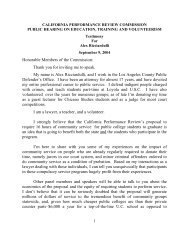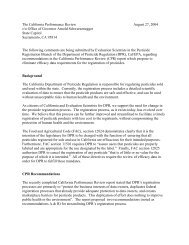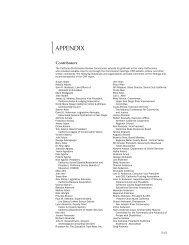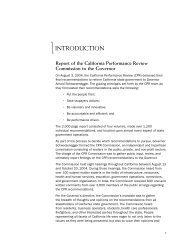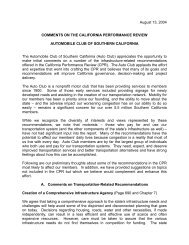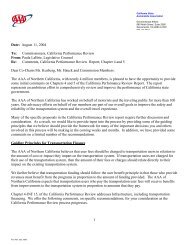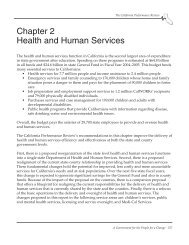Chapter 1 General Government - The California Performance Review
Chapter 1 General Government - The California Performance Review
Chapter 1 General Government - The California Performance Review
- No tags were found...
Create successful ePaper yourself
Turn your PDF publications into a flip-book with our unique Google optimized e-Paper software.
An amnesty program for other outstanding personal income taxes, sales taxes and motorvehicle fees and taxes would generate significant <strong>General</strong> Fund revenue after waiver ofpenalties and costs and some additional revenue to local governments. In addition, selectivelyincreasing the number of audits performed by the three taxing agencies, filling audit andcollection vacancies, modifying the debt collection process of all state agencies andconsolidating and upgrading the mail and collection units of the three taxing agencies wouldproduce additional revenue annually to the <strong>General</strong> Fund.In FY 2002–2003, the State Lottery provided $1.02 billion to K–12 schools and other educationalprograms in <strong>California</strong>, through a lotto program and scratchers. Lottery revenues have grownfrom $2 billion in FY 1995–1996 to a high of $2.7 billion in 2002–2003. However, revenues forFY 2003–2004 and FY 2004–2005 are expected to remain flat. Other states with lotto programshave seen their revenues increase by joining a multi-state game that can offer larger base prizesand larger jackpots that generate more interest and increase lottery sales. Joining one of thesemulti-state lotteries is expected to produce millions in additional revenues for schools andother educational programs. In addition, other states have increased revenues in theirscratcher games by modifying the rules restricting the type of games and by increasing theportion of revenues that goes to prizes. If <strong>California</strong> adopts similar rules, funding foreducation would increase.Creating customer friendly governmentCustomer service should be the front line and bottom line for government bureaucracies—theinteractive face of any entity. However, at times the priorities of the bureaucracy seem to comebefore the needs of those it is meant to serve. Despite paying for government, <strong>California</strong>ns arenot always treated as its customers and its goals do not always reflect their needs. To trulyreinvent <strong>California</strong> government, <strong>California</strong>ns must come first.For example, cable television operators in <strong>California</strong> are required to publish customer servicestandards. Ironically, <strong>California</strong> government fails to hold itself to the same requirement.Publishing consistent customer service standards and disclosing how well these standards aremet is the keystone of changing the face of government. <strong>California</strong> should establish a cohesivestatewide customer service system by requiring all state agencies to develop, publish andreport on customer service standards.<strong>California</strong>’s government also presents a dizzying array of forms, telephone numbers andwebsites, but makes little effort to array information in a user-friendly way. <strong>The</strong>re is no singleclearinghouse or search engine to serve as a starting point. <strong>The</strong> state should establish a<strong>California</strong> Information Center to offer information and services to <strong>California</strong>ns through asingle toll-free telephone number and a companion web portal. In addition, the state shouldestablish a one-stop <strong>California</strong> Business Center to give businesses a single point of access forinformation about licensing, permitting, regulatory matters and other information they need to2 Issues and Recommendations



